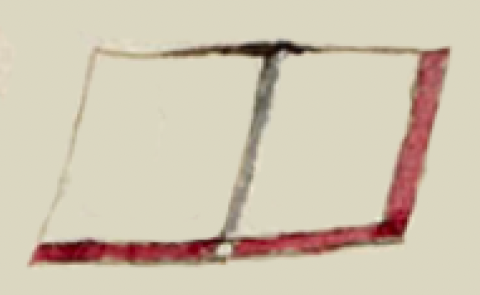libro (CST14)
This painting of the simplex glyph for the term libro, which is a word loaned from Spanish to Nahuatl and means book. The glyph shows a frontal view of an open book. The pages are white and blank. The edges of the pages are red, and the binding in gray. This is a European-style book. The companion text says that white paper was purchased, and a book was to be made at the church.
Stephanie Wood
The loan “libro” is rare in this collection. Most glyphs showing papers and books use Nahuatl glosses. See some examples below. Furthermore, having blank pages is somewhat rare, especially in what appear to be books. Usually, there are markings that suggest alphabetic writing and only rarely suggest possible hieroglyphic writing. For more on the Codex Sierra, see Kevin Terraciano’s study (2021), which provides the transcription and translation of the passage mentioned above.
Stephanie Wood
1550–1564
Jeff Haskett-Wood
libros, liblo, liplo, lipro, papel, escrituras, educacion, alfabetismo, educación

libro, a book (a loan from Spanish that was taken into Nahuatl, https://nahuatl.wired-humanities.org/content/libro
libro
Stephanie Wood
Códice Sierra-Texupan, plate 14, page dated 1554. Origin: Santa Catalina Texupan, Mixteca Alta, State of Oaxaca. Kevin Terraciano has published an outstanding study of this manuscript (Codex Sierra, 2021), and in his book he refers to alphabetic and “pictorial” writing, not hieroglyphic writing. We are still counting some of the imagery from this source as hieroglyphic writing, but we are also including examples of “iconography” where the images verge on European style illustrations or scenes showing activities. We have this iconography category so that such images can be fruitfully compared with hieroglyphs. Hieroglyphic writing was evolving as a result of the influence of European illustrations, and even alphabetic writing impacted it.
https://bidilaf.buap.mx/objeto.xql?id=48281&busqueda=Texupan&action=sear...
The Biblioteca Digital Lafragua of the Biblioteca Histórica José María Lafragua in Puebla, Mexico, publishes this Códice Sierra-Texupan, 1550–1564 (62pp., 30.7 x 21.8 cm.), referring to it as being in the “Public Domain.” This image is published here under a Creative Commons license, asking that you cite the Biblioteca Digital Lafragua and this Visual Lexicon of Aztec Hieroglyphs.









